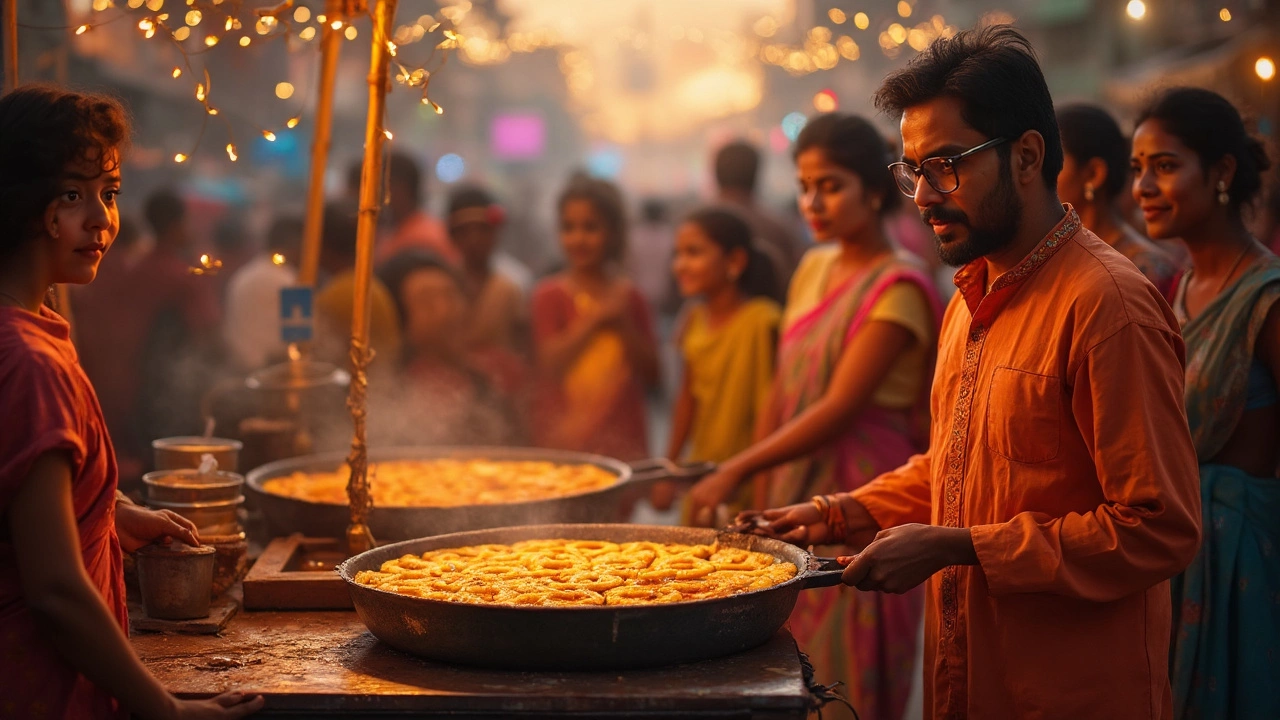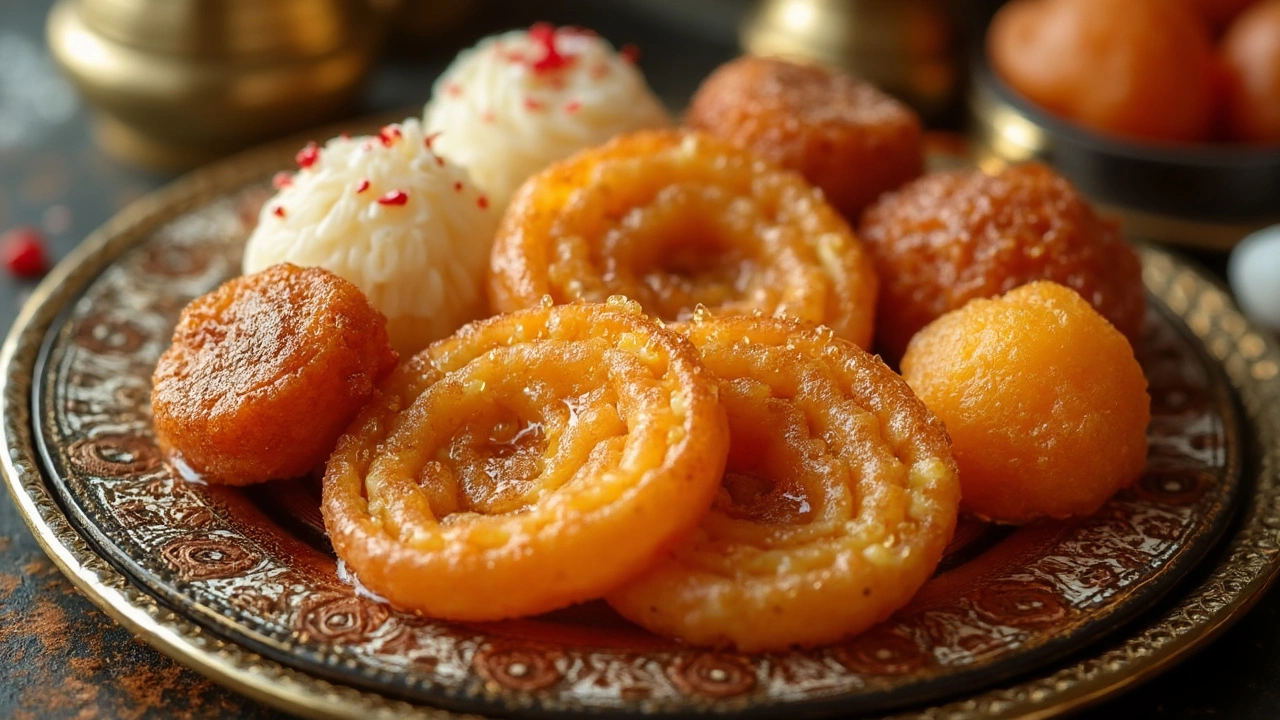India's National Dessert: The Sweet Truth About Jalebi
 May, 20 2025
May, 20 2025
Ask anyone on an Indian street what the national dessert is, and you’ll get a dozen passionate answers. Strangely, India’s got a national animal, a national bird, and even a national fruit, but it never declared an official national dessert. Still, walk down any market lane, and jalebi is the one sweet you can’t miss. Golden, crispy, and swimming in syrup, it's almost always the first thing that catches your eye at sweet shops and food carts.
If you’re visiting India—or just craving real street sweets—knowing why jalebi stands out matters. It’s not because it's the only sweet around. Jalebi just hits differently: hot, bright orange, with that satisfying crunch followed by a sugary burst. Next time you’re exploring Indian street food, you’ll want an insider’s tip on how to spot a fresh batch, and even what to eat it with. Trust me, you don’t want to settle for a limp, cold jalebi when the good stuff could change your day.
- The Big Debate: Does India Have an Official National Dessert?
- Jalebi’s Origin Story: Where Did This Icon Start?
- Why Jalebi Reigns on Indian Streets
- Where and How to Eat the Best Jalebi
The Big Debate: Does India Have an Official National Dessert?
So, here’s the thing—India officially hasn’t named any dessert as its “national” one. No government order, no paperwork, nothing’s been stamped or sealed. But ask around, and you’ll see everyone has an opinion. Sweets play a huge part in India’s food culture. There’s something for every festival, region, or even mood: from rasgulla in Bengal to mysore pak in the South, and laddoo everywhere.
The competition is real. Let’s put the big names side by side:
| Sweet | Where It's Most Loved | Festival/Famous Event |
|---|---|---|
| Jalebi | North, West & Central India | Morning snacks, weddings, Independence Day breakfasts |
| Rasgulla | West Bengal, Odisha | Durga Puja, weddings |
| Gulab Jamun | Pan-India | Any celebration, Diwali, Eid |
| Laddoo | Pan-India | Religious offerings, birthday rituals |
When Google ran a poll in 2020 asking about India’s national dessert, jalebi came out on top. That got tons of people cheering—and arguing—on social media. Still, there’s no rulebook. The confusion means you’ll find news articles and debates every year, usually around Independence Day or major festivals, arguing which sweet best represents India.
If you’re in India or just curious, there’s a quick tip: nobody’s wrong. Your favorite sweet probably has a place in someone else’s “national” list. But when it comes to being everywhere and instantly recognized, jalebi really does stand out. It’s the dessert you’ll spot from the smallest roadside cart all the way up to big weddings. That’s why it ends up in these debates again and again.
Jalebi’s Origin Story: Where Did This Icon Start?
It might surprise you, but jalebi didn’t actually start in India. Most food historians say its roots go way back to the Middle East, where it showed up as ‘zalabiya’ or ‘zalabia’ in ancient cookbooks. This sweet made its way to India sometime between the 13th and 15th centuries, thanks to Persian traders and travelers. Once it hit Indian kitchens, it got a new twist—more crunch, brighter color, and a sweeter, thicker syrup—that basically made it the india national dessert for thousands.
You’ll find recipes for something super close to jalebi in medieval Arabic cookbooks. But India didn’t just borrow it—locals completely owned it, adding their own vibes and making it a dessert you’ll spot everywhere from street stalls to five-star hotels.
“Jalebi is one of those sweets that Indians have truly made their own, even though its origins are found in the Middle East. Over centuries, it’s become deeply woven into our festivals and daily life.” — K.T. Achaya, Indian food historian
Jalebi is now served up for breakfast in North India (often with curd or rabri), handed out in temples, or used to sweeten up any celebration. Curious just how big jalebi has gotten? Check out this data on India’s sweet consumption:
| Sweets Category | Annual Sales (tons, 2024) |
|---|---|
| Jalebi | 30,000+ |
| Gulab Jamun | 22,000 |
| Ladoo | 18,000 |
No other sweet gets as much limelight during Indian weddings, Independence Day mornings, or even random weekends. It’s wild how a centuries-old snack from another land became the comfort food for a billion people—and counting.

Why Jalebi Reigns on Indian Streets
Jalebi has become the face of Indian sweets for more than just its bright looks. This spiral treat is everywhere because it’s cheap, quick to make, and packs a flavor punch that people of all ages crave. Walk through any major city or small town, and you’ll find jalebis sizzling in hot oil at the crack of dawn, right next to chai stalls and breakfast vendors.
Ask any vendor why they sell jalebi all year, and you hear the same thing: it sells out, fast. Why? For starters, it's a crowd-pleaser during festivals, school events, and weddings. It works for breakfast, as a snack, or even after a heavy meal. The real trick is its simplicity—just flour, curd, sugar, and a few spices, fried and dunked in syrup.
You’ll spot jalebi stacked high in markets across regions, but it doesn’t stop there. Did you know in North India, people love soaking jalebi in hot milk for breakfast? Head to the West, especially Gujarat, and you’ll see it paired with fafda (a salty chickpea snack) every Sunday. Versatile doesn’t even begin to cover it.
“Jalebi is that rare Indian sweet which never fails to attract, whether on a street corner or in a five-star hotel,” said chef Kunal Kapur in an interview with The Times of India.
Here’s what really makes jalebi stand out among Indian desserts:
- India national dessert option at every level—from street stalls to fancy sweet shops.
- Ready in minutes, so every bite tastes fresh and warm.
- Sells for a few rupees, making it easy on the pocket.
- Appeals to people crossing generations; grandparents and preschoolers dig in equally.
- Crispy on the outside, juicy on the inside—nobody forgets the texture.
To put things in perspective, check out this data on jalebi sales compared to other popular sweets on city streets:
| Sweet | Average Daily Street Sales (Pieces/Vendor) | Price Per Piece (INR) |
|---|---|---|
| Jalebi | 350 | 6 |
| Gulab Jamun | 220 | 10 |
| Rasgulla | 170 | 10 |
| Sandesh | 90 | 12 |
Jalebi just keeps things real—hot oil, bubbling syrup, and a line of impatient customers every morning. That’s why it’s the go-to sweet on Indian streets, no question about it.
Where and How to Eat the Best Jalebi
If you really want to find the best jalebi in India, you should skip hotel restaurants and go straight to the street. The tastiest jalebis are fried right in front of you, sizzling in oil, then dunked straight into sugar syrup. Here’s what matters most—freshness. If the jalebi is hot and crispy, you’re in the right spot. If it’s cold or looks soggy, move on.
Most local foodies swear by old-school sweet shops and corner carts instead of big chains. In Delhi, places like Chandni Chowk’s Old Famous Jalebi Wala have lines out the door for good reason—they’ve been doing this for over a century. Mumbai’s Bhendi Bazaar, Lucknow’s Chowk, and Kolkata’s Burrabazar also have legends serving up jalebis from early morning till late night. Not sure how early to show up? Prime time is between 7 and 10 AM or around 5 PM, when fresh batches come out for breakfast and evening snacks.
- If you see a crowd at a stall, that’s almost always a good sign—locals know where the best jalebi is coming out hot and fast.
- Ditch the fork. Jalebi is best eaten with your hands. It’s messy, but that’s half the fun.
- Pair it with a glass of hot, creamy milk or a serving of rabri (a sweet, thickened milk dish) if you want the real deal experience.
- Don’t wait till you get home. Jalebi loses its crunch quickly, so eat it right there at the stall.
Here’s a quick look at famous jalebi hotspots and how much a piece usually costs:
| City | Famous Spot | Average Cost (per plate) |
|---|---|---|
| Delhi | Old Famous Jalebi Wala | ₹40-₹60 |
| Mumbai | JJ Jalebi, Bhendi Bazaar | ₹30-₹50 |
| Kolkata | Bharati Jalebi, College Street | ₹20-₹40 |
| Lucknow | Radhey Lal Sweets, Chowk | ₹25-₹40 |
| Jaipur | Laxmi Misthan Bhandar | ₹40-₹60 |
For serious fans of jalebi, asking locals is always smarter than googling reviews—word travels fast when the jalebi is good. Got a sweet tooth but don’t have travel plans? Some shops deliver in big cities, but nothing matches the taste when it’s straight out of the fryer. So if you spot jalebi being made fresh, don’t just walk by. Stop, grab a piece, and eat it while it’s crackling hot.
